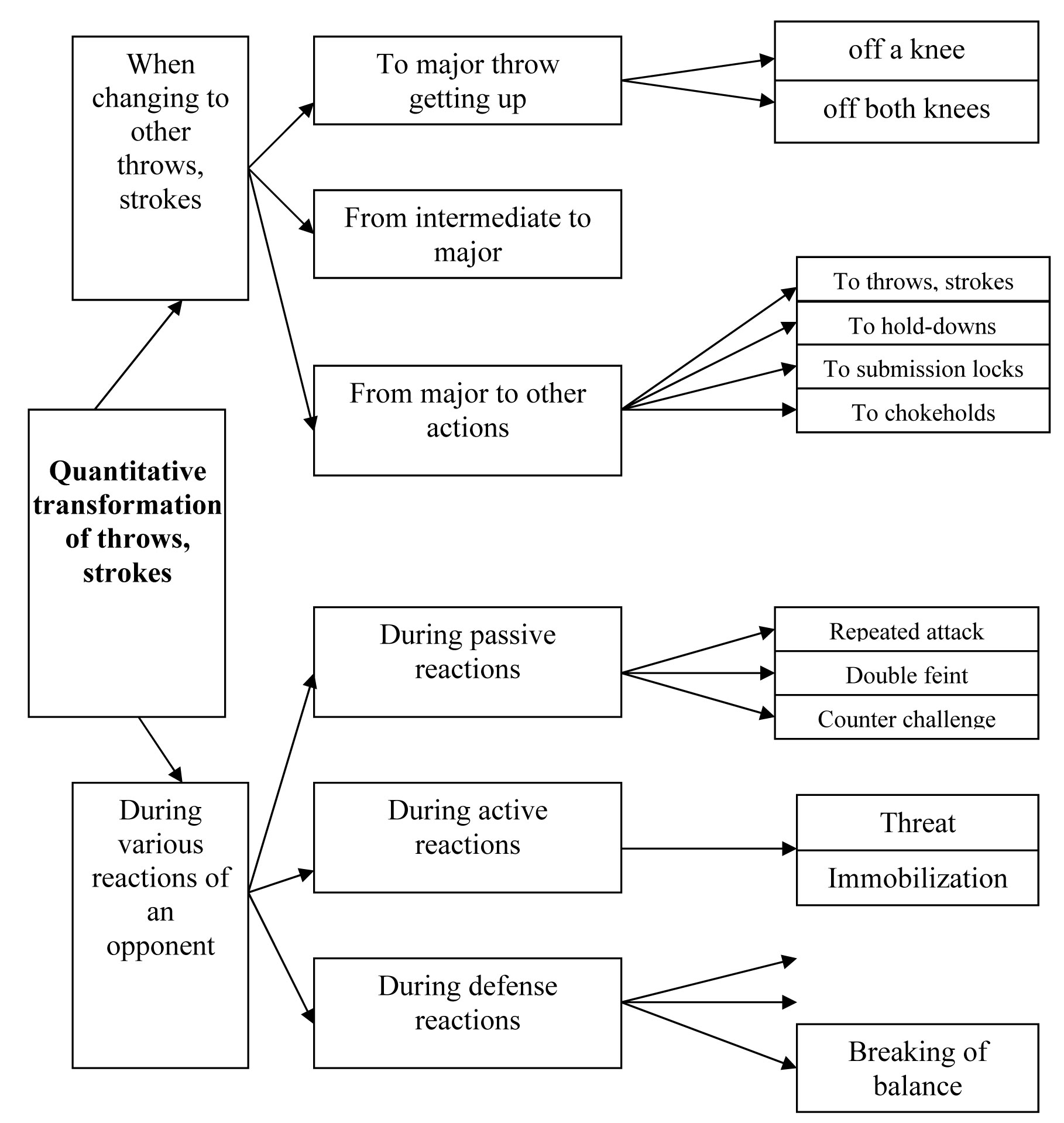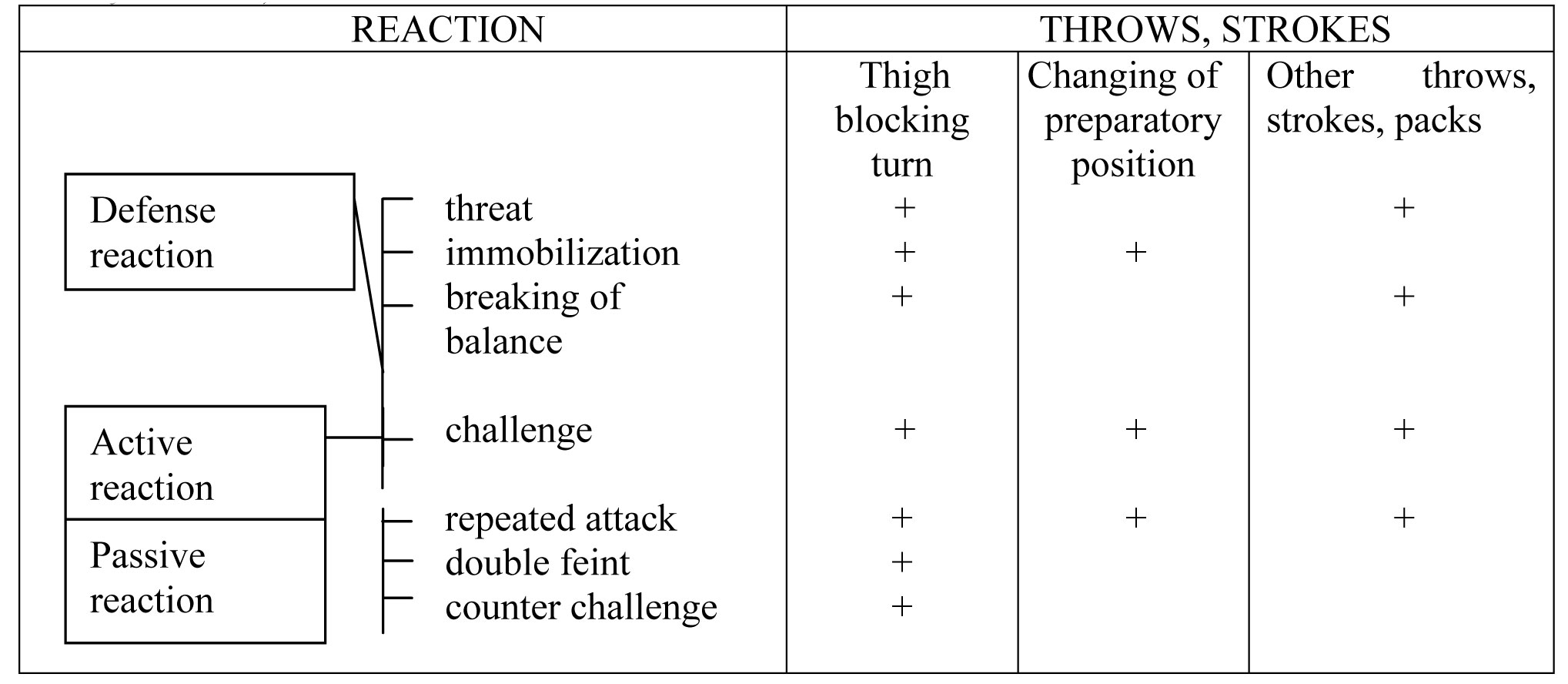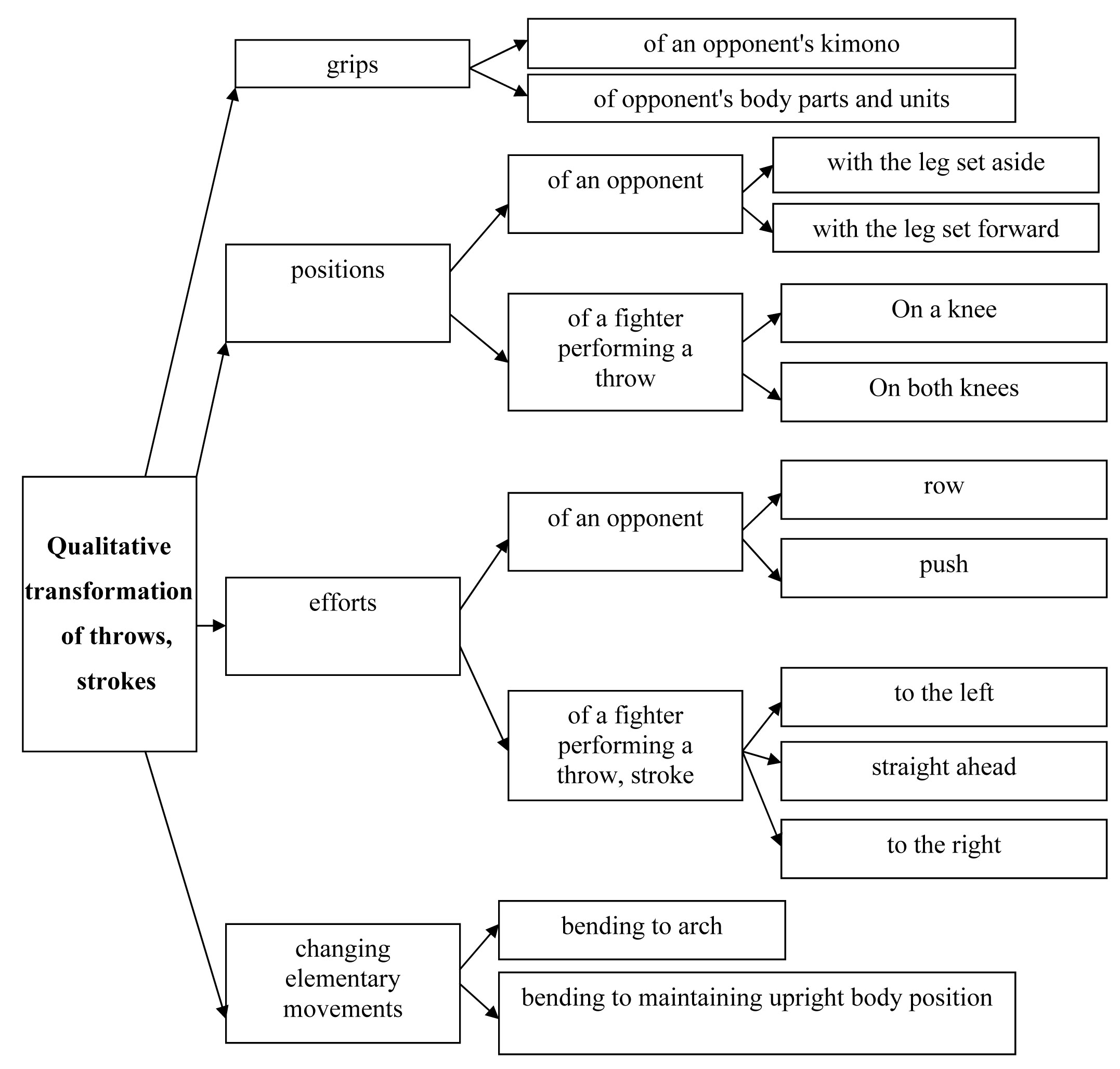Transformation of Attacking Actions in Hand-to-Hand Fight
Фотографии:
ˑ:
I.D. Svischev, professor, Dr.Hab.
A.V. Ponkratov, postgraduate
Russian State University of Physical Culture, Sport, Youth and Tourism (SCOLIPhC), Moscow
Key words: transformation of attacking actions, throws and strokes, technique of hand-to-hand combat.
Introduction. Of general theory of systems three major types of transformation such as quantitative, qualitative and relative (Yu.A. Urmantsev, 1988) are interesting in respect to the analysis of the technique of hand-to-hand combat. Transformation of a throw (stroke) in hand-to-hand combat is the process resulting in one throw (stroke) replaced by another, belonging to the same classification group.
The purpose of the research was to improve the content of the technique of hand-to-hand combat.
Results and discussion. Changing the number of elementary movements in a throw (stroke), we conduct a quantitative transformation of the throw. The relative transformation of the throw (stroke) presupposes changing the sequence of performance of elementary movements. The qualitative transformation presupposes the ability to change grips, positions, efforts and elementary actions (Fig. 1).
Fig. 1. Transformation of a throw (stroke) in hand-to-hand combat
Quantitative transformation
During the quantitative transformation of a throw (stroke) the number of elementary movements, its constituents, varies. There were defined transformations of a throw (stroke) in case of: 1) different reactions of an opponent; 2) fighter changing to perform other throws (strokes) (Fig. 2).

Fig. 2. Quantitative transformation of throws, strokes in hand-to-hand combat
Transformation of a throw is influenced by defense, active and passive reactions to the actions of the one who attacks (A.N. Lents, 1967). In order to induce an opponent's defense reaction a fighter uses "threat", "neutralization", "breaking of balance".
We consider threat as the illusion of an active action that forces an opponent to use defense, which, in its turn, enables a fighter to make the intended attack rolls. When an opponent got used to "pre-dosed" defense already, a fighter increases speed and strength at just the right time, changes the attack vector and attacks other parts (units) of an opponent's body.
"Immobilization" limits an opponent in his actions and makes him use defense, which enables a fighter to make the intended attack rolls. Breaking a hold, an opponent lessens control over his own actions and by that contributes to the attack.
"Breaking of balance" makes an opponent take measures for maintaining stability, which distracts him from the actions of the one who attacks, and again that enables the latter to make the intended attack rolls. Those might be either whips or pushes (while stepping forward, stepping backward, etc) (Table 1).
During an opponent's active reaction a fighter challenges him to counteractions that would allow performing the intended throw, stroke.
During this "challenge" purposeful creation of specific situations and playing them off as random helps a fighter disorientate an opponent, and thus get ahead of him and make an attack roll.
When it comes to passive reaction, an opponent either does not respond or responds by "weakened" defense or loosening up. With that "repeated attack", "counter challenge", "double feint" are used.
"Repeated attack" is the "inurement" of an opponent to multiple "weakened" application of one and the same hold with succeeding unexpected attack by means of the same hold which is made with much more effort than before (A.N. Lents, 1967).
During the "counter challenge" all active actions are ceased intentionally and that makes an opponent react accordingly (he relaxes), then a fighter attacks by making the intended rolls.
During the quantitative transformation of the technique of hand-to-hand combat, out of a number of basic and more frequently used, around 1800 of different combinations are implemented during the bout.
Table 1. Transformation of throws, strokes during various reactions of an opponent (quantitative transformation)

Therefore, using an opponent's reaction a fighter performs throws, strokes transforming their content. For instance: performance of a throw by picking up during the "immobilization" of an opponent differs much from performing a throw by picking up during the "threat" of a side undercut.
Another significant component of the quantitative transformation is alteration of the quantity of elementary movements in throws, strokes when passing from performing:
1) major throws, strokes to other rolls;
2) intermediate rolls to major throw, stroke.
From major throws one can pass to making other types of throws, as well as strokes, hold-downs, submission locks, chokeholds. However, there is a possibility to perform other throws, strokes getting up:
1) off a knee;
2) off both knees.
In these cases, the number of elementary actions changes which characterizes the quantitative transformation of throws (Table 2).
Table 2. Transformation of throws, strokes during various switches to performance of other holds (quantitative transformation)
|
Switches |
Throws, strokes |
|||
|
From intermediate throws, strokes to major ones |
Thigh blocking turn or stroke
+ |
Changing of preparatory position
|
Other throws, strokes
+ |
|
|
From major throws, strokes to other types of throws, strokes, to submission locks, hold-downs, chokeholds. |
+ |
+ |
+ |
|
|
To major throws, strokes getting up |
off a knee |
+ |
+ |
+ |
|
off both knees |
+ |
+ |
+ |
|
Qualitative transformation
Qualitative transformation of a throw is carried out (Fig. 3):
1) by means of grips of a kimono, parts and units of an opponent's body;
2) in view of positions of a fighter and his opponent;
3) in view of efforts of an opponent and a fighter;
4) with changing elementary movements in a throw, stroke.
During the qualitative transformation the following types of grips are used - of the kimono (of a sleeve and a belt - from the front, from the back; of a sleeve and a belt over the same shoulder; crossing the gripped hands; of the sleeves on the shoulder; of the sleeves under the shoulder; of the sleeves and the lapel; scissors lapel grip); of opponent's body parts and units (of arms and legs - inner, outer grips; by one arm, by both arms - inner, outer grips; of arm and body; of arm and neck; of arm and forearm by the elbow bend).

Fig. 3. Qualitative transformation of throws in hand-to-hand combat.
Transformations in view of changing positions presuppose creation of the situation favorable for a throw in case of the following opponent's positions:
1) with the left or right leg set aside;
2) with the left or right leg set forward.
A fighter performing a throw changes his position significantly by going down on a knee or knees which contributes much to the content of a throw, stroke (Table 3).
During the qualitative transformation of hand-to-hand combat technique over 1500 options for implementation have been revealed.
Table 3. Transformation of throws, strokes in view of positions of an opponent and a fighter, performing a throw, stroke (qualitative transformation)
|
Positions |
Throws, strokes |
|||
|
Thigh blocking turn or stroke |
Changing of preparatory position |
Other throws, strokes, packs
|
||
|
Position of an opponent |
With the leg set aside |
+ |
+ |
+ |
|
With the leg set forward |
+ |
+ |
+ |
|
|
Position of a fighter performing a throw, stroke |
Going down on a knee |
+ |
+ |
+ |
|
Going down on both knees |
- |
+ |
+ |
|
An opponent may push on a fighter, pull him on, and a fighter performing a throw has a chance to direct his efforts to the left, straight ahead, or to the right. With that, he can perform a throw by changing from bending to an arch or bending to falling of the straight body (Table 5).
Relative transformation. The relative transformation of a throw, stroke is carried out changing the sequence of performance of elementary movements. During the transformation of a throw while turning one’s back on an opponent, the following is considered: the sequence of putting of a "barrier" leg, leg swing, seat, beat, stepping aside.
Table 4. Transformation of throws in view of efforts of an opponent and a fighter performing a throw
|
Efforts |
Throws, strokes |
|||
|
Thigh blocking turn or stroke |
Changing of preparatory position |
Other types of throws, strokes |
||
|
Efforts of an opponent |
Push |
+ |
+ |
+ |
|
Row |
+ |
+ |
+ |
|
|
Efforts of a fighter making a throw, stroke |
To the left |
+ |
+ |
+ |
|
Straight ahead |
+ |
+ |
+ |
|
|
To the right |
+ |
+ |
+ |
|
Table 5. Transformation of throws when changing elementary movements (qualitative transformation)
|
Changing |
Throws |
||
|
Thigh blocking turn |
Changing of preparatory position |
Other types of throws |
|
|
Changing from bending to arching |
+ |
+ |
+ |
|
Changing from bending to straight body falling |
+ |
+ |
+ |
Table 4 represents a list of options for performance of a throw by means of thigh blocking turn. In order to master throws, strokes on the skill level it is necessary to implement all the variants on the partners of different height and weight who do not fight back. To master the options for performance of throws, strokes on the motor skill level it is necessary to use them on the partners who do fight back, as well as under conditions of training bouts with judging.
Over 1000 different combinations of the number of basic and most common are applied in a fight during the relative transformation of the technique of hand-to-hand combat.
Conclusions:
1. Over 4300 options for implementation have been revealed during the transformation of technical actions of hand-to-hand combat.
2. Over 1800 variants of implementation have been detected during the quantitative transformation of technical actions.
3. Over 1500 options for implementation have been revealed during the qualitative transformation.
4. Over 1000 variants of implementation have been allocated during the relative transformation.
References
- Igumenov, V.M. The concept of the "sports confrontation model", its scientific and practical senses / V.M. Igumenov, R.A. Piloyan, G.S. Tumanyan // Teoriya i praktika fizicheskoy kultury. – 1986. – № 9. – P. 24-26. (In Russian)
- Piloyan, R.A. Methodology of research of the competitive fight in wrestling / R.A. Piloyan, V.I. Medin, Yu.I. Polunin // Teoriya i praktika fizicheskoy kultury. – 1979. – № 1. – P. 12- 14. (In Russian)
- Reznikov, Yu.A. Objective criteria for evaluating the effectiveness of the technology in sports with subjective assessment: abstract of Ph.D. thesis / Yu.A. Reznikov. – Moscow, 1974. – 24 P. (In Russian)
Corresponding author: viktorrovi4@yandex.ru




 Журнал "THEORY AND PRACTICE
Журнал "THEORY AND PRACTICE